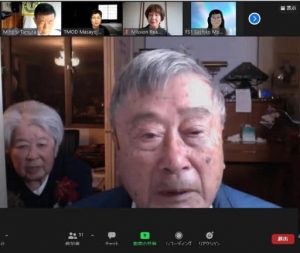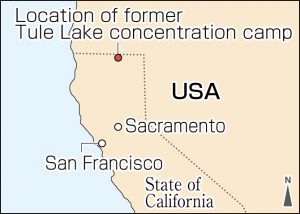Second-generation Japanese American Jack Dairiki shares his wish for peace, recalls hardships of war in online meeting Experienced atomic bombing while staying in Hiroshima
Jul. 13, 2021
by Kyoko Niiyama, Staff Writer
Jack Dairiki, 90, a second-generation Japanese American living in San Francisco, California, is an atomic bomb survivor. He shared his experience of the atomic bombing with people in Hiroshima in an online meeting. Born in the United States, Mr. Dairiki experienced the atomic bombing at the age of 14 in Hiroshima, his father’s hometown. His mother and other family members in the United States went through many hardships in an internment camp for people of Japanese ancestry. This meeting was the first opportunity for Mr. Dairiki to convey to Japan his strong wish for peace which he has always had living in the U.S., the country that used atomic bombs.
Mr. Dairiki was born in 1930 in Sacramento, California, the location his parents had moved to after leaving Hiroshima. In August 1941, Mr. Dairiki visited Hiroshima with his father to see his sick grandfather. They had planned to stay there for one month. But while they were trying to obtain their passage tickets to go back to the U.S., Japanese forces attacked Pearl Harbor and the Pacific War began. They had to give up the idea of going back to the U.S.
Mr. Dairiki was admitted into a national school in the village of Okukaita (now the town of Kaita), but he had a hard time because he “didn’t understand the Japanese language at all.” As he was around the same age as his aunt Sizuko Abe (nee Dairiki), 94, a resident of Minami Ward, she kindly helped him with the language and with studying. He entered Kure City Technical School (now Kure Technical High School) and “worked as hard as other students did” as a mobilized student in 1945. The work actually involved war efforts against the U.S., but he was trying very hard to adapt himself to his surroundings.
He was at Toyo Kogyo (now Mazda Motor Corporation) in the town of Fuchu when the bomb detonated. He was about to leave for the center of Hiroshima to help dismantle houses to create a fire break. “We didn’t leave as early as on other days. If we had arrived at the city center earlier….”
The rest of his family living in Sacramento were sent to the Tule Lake concentration camp in the northern part of California. His mother gave birth to a girl there. His younger brother died at the age of 8.
After going back to the U.S. in 1948, Mr. Dairiki worked as an architect. As he grew older, he began to tell his experience at a temple in San Francisco and at local colleges. The bomb’s heat rays burned the right side of Ms. Abe’s body, but she played a big role in the A-bomb survivors’ movement and sharing of A-bomb experiences since the 1950s despite her suffering. She is well known both at home and abroad. She and Mr. Dairiki have kept exchanging letters, cheering each other up.
This online meeting was organized by the Hiroshima Phoenix Toastmasters Club, which works on training leaders and expressing themselves in English. Fifty-one people attended the meeting. Mr. Dairiki said, “As I felt a blinding light, I covered my eyes with my fingers and fell down to the ground.” He also described with gestures what he saw, including people pleading for water and people walking while dragging the skin of their arms which peeled off because of burns.
Asked his opinion about nuclear weapons, he said, “The use of nuclear weapons inflicts immeasurable harmful effects on the health of people and the environment all over the world. This is the reason why it is important not to use them and not to let people use them.” Bunzo Suzuki, 81, the head of the club, said, “I believe he had to go through incredible hardships while he kept conveying his experience in the U.S. We will hand down his wish for peace in Hiroshima.”
(Originally published on July 13, 2021)








